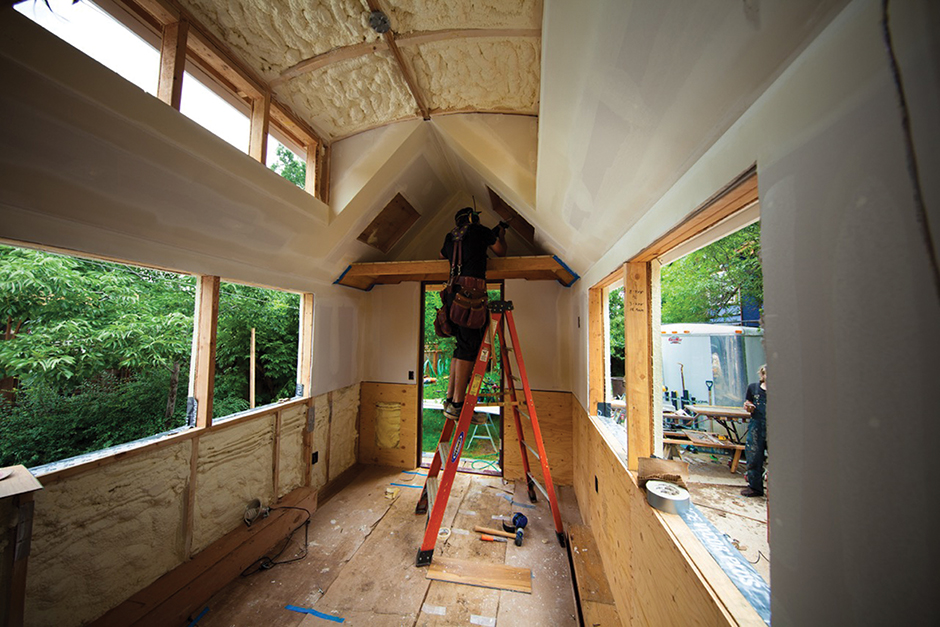A Tiny House Provides a Big Lesson on Energy Savings
Plastics are key building materials in very small houses, and in standard houses as well
Previous Article Next Article
By American Chemistry Council (ACC)
A Tiny House Provides a Big Lesson on Energy Savings
Plastics are key building materials in very small houses, and in standard houses as well
Previous Article Next Article
By American Chemistry Council (ACC)
A Tiny House Provides a Big Lesson on Energy Savings
Plastics are key building materials in very small houses, and in standard houses as well
Previous Article Next Article
By American Chemistry Council (ACC)

Zack Giffin of FYI TV’s Tiny House Nation tows the Plastics Make it Possible tiny house through the hills of Boulder, Colorado.

Zack Giffin of FYI TV’s Tiny House Nation tows the Plastics Make it Possible tiny house through the hills of Boulder, Colorado.

Dow Powerhouse solar shingles play two roles: roof protector and renewable energy generator.

Spray polyurethane foam insulation in the walls and roof improves the energy efficiency of this tiny house.
Note: This article continues the series of updates in Plastics Engineering from Plastics Make it Possible®, an initiative sponsored by America’s Plastics Makers® through the ACC.
Apparently, tiny houses are quite the rage these days in the USA. Media outlets from the Today show to The Huffington Post have highlighted thousands of tiny houses. Television networks from FYI to HGTV have entire shows dedicated specifically to tiny houses. Classes on building tiny houses fill up in a flash. A tiny house “jamboree” in Colorado Springs attracted 40,000 people in August. And officials in Sonoma County, California, are contemplating a tiny house village, similar to an RV park. Plus, the movement is spreading globally.
The idea of the tiny house is hardly new. To help focus on simplifying his life, way back in the mid-1800s American writer Henry David Thoreau lived in a 10 by 15 foot (3 by 4½ m) cottage he built himself by a pond, which inspired his well-known book Walden.
However, the “movement” to drastically shrink house size and cost is hardly mainstream at this point. Despite dramatically lower construction costs—typically between $20,000 and $40,000 for today’s tiny houses compared to an average of $282,000 for new U.S. houses—not that many people are willing to live in a tiny house, usually defined as ranging from 100 to 400 square feet (9-37 m2) in footprint.
Still, the nascent movement is raising some serious questions about the impact of housing on the environment. At an average 2,700 square feet (250 m2), today’s U.S. homes obviously require lots of materials and resources to build and to heat and cool. Plus, houses and buildings in the USA use 41% of the nation’s energy, much of which is wasted due to outdated building practices.
“Green” Features of Tiny Houses
Tiny houses obviously can reduce total building material used, along with energy needed to heat and cool homes—but only for the tiny house owners. Can the tiny house movement shine a spotlight on the nation’s non-tiny house energy use? And can it perhaps help highlight advances in building materials—particularly those made with plastics—that can reduce energy use and waste in homes, tiny or otherwise?
This idea inspired Plastics Make it Possible to partner with Zack Giffin, the star of FYI TV’s Tiny House Nation, and builder Paul Baumann to construct a tiny house in Boulder, Colorado, USA. The house highlights how advances in plastic building products can help homeowners become more energy efficient, while also creating a durable, low-maintenance house.
To optimize energy efficiency and occupant comfort, Giffin and Baumann started by creating a tiny house design that views the building as a system, rather than simply a bunch of disparate parts that get cobbled together. This approach addresses how all of the independent parts of the house—appliances, heating/cooling, hot water, ventilation, occupant behavior, and so on—interact with each other to create a system.
So rather than simply saying, “Oh, it would be cool if we had a hot tub,” the question becomes, “How would a hot tub affect everything else in this house?” (And no, they did not add a hot tub.) Understanding how the various aspects of a house interact with each other can help improve its energy efficiency, comfort, and safety—and perhaps its overall durability and value over time.
As a key part of their systems approach, Giffin and Baumann paid special attention to the building envelope—the physical barriers to heat/cold, air, water, light, and noise that separate the inside conditioned space from the outside unconditioned area. They used readily available building materials that any homebuilder can acquire. Member companies of the Plastics Division of the American Chemistry Council helped out by donating or arranging donations of many of the building products that help insulate and “seal” the building envelope of the tiny house.
What makes this tiny home particularly energy efficient is that individual products were combined to create a continuous sealed barrier between the exterior and interior of the home. The house’s building envelope behaves as a system with all of the parts working together to create something much greater than what any building component would achieve by itself. Compared to traditional construction techniques, less of the home’s climate-controlled air escapes, and outside air is less likely to penetrate the home’s living spaces. This approach obviously can work with any size house.
Key Plastic Products
Let’s look at some of the primary products Giffin and Baumann used to seal the building envelope and improve energy efficiency:
- Spray polyurethane foam insulation expands to fill spaces in walls and attics, sealing tough-to-reach corners and cracks, which can help dramatically improve energy efficiency. It also helps keep out dust, dirt, and insects.
- Vinyl siding and trim provide an additional barrier between indoors and out, plus they are typically low-maintenance and resilient and don’t need periodic painting, and they are manufactured to withstand the elements and resist fading.
- Polyisocyanurate foam board was applied to the outside of the tiny house walls (under the siding) to help prevent untreated air from even touching the wall materials/framing; this further insulates the house from the weather and can reduce the energy needed for heating and cooling.
- Innovative plastic solar shingles play two roles: roof protector and renewable energy generator. The durable, engineered plastic shingles combine the aesthetics and profile of traditional shingles while eliminating the bulk and height of traditional solar panels.
- Plastic window frames can be excellent insulators, partly because polymers such as vinyl have a high resistance to heat and cold. In addition, the plastic frames incorporate air gaps that help reduce the transfer of outside temperature into the house.
- A tough plastic skylight helps provide natural daylight, thermal resistance, and UV protection to help save energy. While it may not be quite as tough as bulletproof glass, it’s made from one of the primary materials of the laminated glass: polycarbonate.
- A traditional-looking door made with tough polyurethane-based fiberglass can look remarkably like wood grain. The polyurethane/fiberglass coating and an insulating plastic foam core provide resistance to heat/cold.
- Extruded polystyrene foam insulation provides an insulating barrier beneath the flooring of the tiny house, which is useful in most houses—particularly so in this one since it’s mounted to a platform on a trailer.
- Flexible, water-resistant plastic (such as silicone) caulking and sealants help fill gaps around pipes, air ducts, plug outlets, and other places where outside air can enter a house.
- Tough but flexible PEX (cross-linked polyethylene) piping used in the tiny house retains more heat in hot-water lines than traditional piping, and this can reduce energy needs. Plus PEX can expand up to three times its diameter to resist freeze damage.
Giffin and Baumann added additional indoor building products, such as luxury vinyl tile, composite counter tops, and wall coverings made with plastics. They chose durable materials specifically because tiny houses often are mounted on trailers to make them mobile and thus require building materials that are tough, long lasting, and impervious to water. These characteristics would benefit any size home.
The result? An attractive, well-insulated, durable 8.5 by 20 foot (2.6 by 6.1 m) home that can serve as a roving testament to the advances in building products made possible by plastics.
It’s unclear whether interest in tiny houses will wax or wane in coming years. As home prices and the cost of living rise, tiny homes may become more attractive as a way to reduce up-front home costs, maintenance, and heating/cooling expenses.
Regardless, Plastics Make it Possible is leveraging this handsome tiny house—and interest in the growing tiny house movement—to highlight the role plastics can play in improving the energy efficiency and durability of these small homes. Or urban row houses. Or suburban ranch houses. Or beach bungalows. Or condominiums. Or...
For more about this tiny house and plastics and sustainability, visit plasticsmakeitpossible.com.
